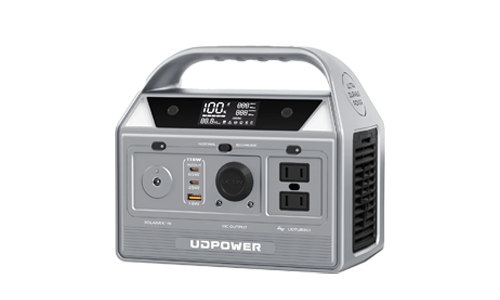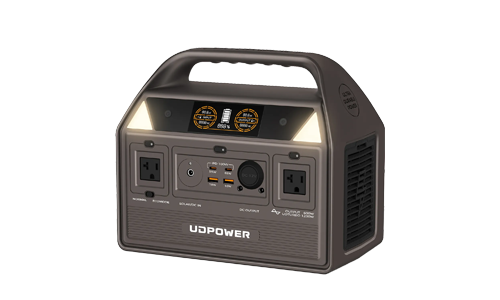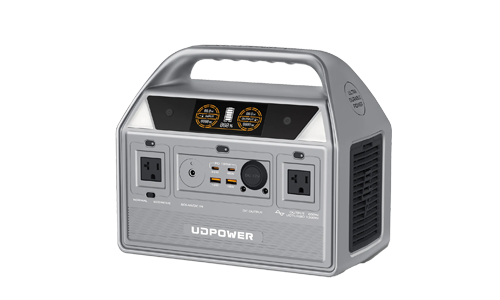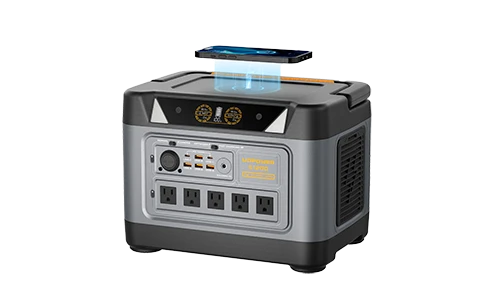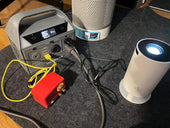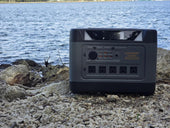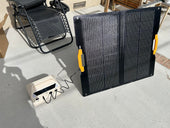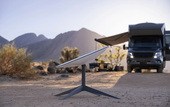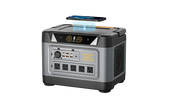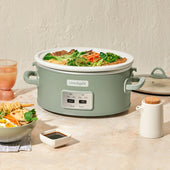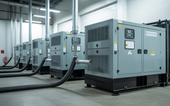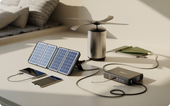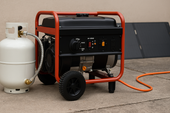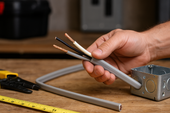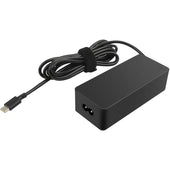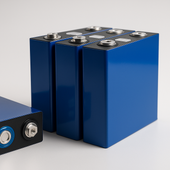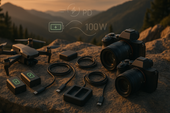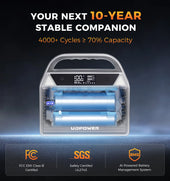Inverter Generator vs. Portable Power Station: What to Get?
ZacharyWilliamYour best choice depends on how much power you need, how long you need it, and where you’ll use it. Below you’ll find clear definitions, sizing math, real-world scenarios, cost/safety notes, and a practical decision flow—plus smart places to mix in a hybrid setup.
TL;DR (Quick Comparison)
| Factor | Inverter Generator | Portable Power Station (PPS) |
|---|---|---|
| Indoors | ❌ CO risk | ✅ No exhaust |
| Noise | Audible (50–65 dB typical) | Near-silent (fan noise) |
| Runtime | Unlimited with fuel | Finite (battery); extend via charging/solar |
| Surge Handling | Excellent for motors | Good to limited (model-dependent) |
| Maintenance | Oil, plugs, carb, fuel | Minimal (battery care) |
| Operating Cost | Fuel-dependent | Grid low; Solar near-zero marginal |
| Emissions | Tailpipe; outdoor use only | Zero at point of use |
| Weather/Altitude | Altitude derate; rain cover | Cold-charge limits; otherwise fine |
Quick Definitions
What is an Inverter Generator?
An engine spins an alternator; output is rectified and inverted into clean, stable AC. Quieter and more efficient than open-frame generators, but still produces exhaust. Outdoor-only operation.
What is a Portable Power Station?
A rechargeable battery + inverter in one box (often long-life LiFePO₄). Multiple ports (AC/DC/USB), MPPT solar input, and near-silent operation. Safe indoors with no emissions at point of use.

Core Differences at a Glance
| Criterion | Inverter Generator | Portable Power Station |
|---|---|---|
| Continuous / Surge Watts | 1–3 kW common; strong surge | Model-dependent; surge capped by inverter |
| Energy “Tank” | Fuel tank; refuel to extend | Battery (Wh/kWh); recharge to extend |
| Fuel / Charging | Gas/propane | AC, 12V car, solar, or generator |
| Noise | Audible hum | Very low (fans) |
| Indoor Use | No (CO risk) | Yes |
| Maintenance | Regular engine service | Minimal |
| Operating $/kWh | Fuel-dependent | Grid low; solar near-zero marginal |
| Portability | Unit + fuel handling | No fuel to carry |
| Weather/Altitude | Needs cover; derates at altitude | Mind cold-charge limits |
| Expandability | Parallel kits on some | Extra batteries/solar on some |
| Regulations | Noise & emissions rules | Typically fewer restrictions |
How to Size What You Need
- List loads (running vs starting watts)—motors need a short surge.
- Compute peak requirement—ensure your source covers the largest surge.
- Estimate energy (Wh)—Power (W) × Hours × Duty-cycle.
Example: Fridge + Lights + Wi-Fi (8h)
- Fridge 150 W @ 30% duty → 360 Wh
- LEDs 50 W × 8 h → 400 Wh
- Router 10 W × 8 h → 80 Wh
Total ≈ 840 Wh (cover surge ~800–1,200 W). A ~1–1.2 kWh PPS or a modest IG works.
Example: CPAP Overnight (8h)
Without humidifier: 30 W × 8 h = 240 Wh.
With humidifier: 60 W × 8 h = 480 Wh.
Example: RV Air Conditioner
Run ~1,300 W; start ~2,500–3,000 W (less with soft-start). A 2–3 kW IG is straightforward; PPS needs high-surge and ample capacity or hybrid charging.
Example: Circular Saw (Intermittent)
~1,200 W while cutting; ~10 min/hour → ~200 Wh per hour of work. PPS can handle intermittent tasks; IG excels for continuous multi-tool use.
Use-Case Playbook
Apartments & Indoor Backup
PPS wins—quiet, emission-free, safe indoors. Great for routers, phones, laptops, light strings, dorm-size fridges.
Suburban Home (Short Outages <24h)
Either solution works. PPS keeps essentials quiet; IG makes larger loads easy. Hybrid gives flexibility.
Multi-Day Storms
IG advantage for unlimited runtime (with fuel). Hybrid: run IG by day to recharge a PPS, then enjoy silent indoor power at night.
RVs/Vanlife
PPS + solar for boondocking essentials; add a small IG for AC or long cloudy spells. Consider soft-start to reduce surge.
Camping / Quiet-Hour Parks
Noise rules often restrict generators. PPS is the courteous choice for campsites, tailgates, and late-night power.
Jobsites
IG for heavy/continuous draw; PPS for sensitive electronics and intermittent tools.
Decision Framework
- Indoors or strict quiet? → PPS
- Need >2–3 kW continuous or multi-day runtime? → IG (or hybrid)
- Want fuel-free + solar? → PPS (add panels)
- Want the best of both? → Hybrid: IG recharges PPS
Cost & Ownership
Upfront
- Inverter Generators: ~ $500–$2,000+ (size/features)
- PPS: ~ $300–$4,000+ (capacity/inverter)
Operating Cost ($/kWh)
Method (Gallons/h × $/gal) ÷ kW load = $/kWh
Example: 0.12 gal/h at 500 W, $4/gal → (0.12×4)/0.5 ≈ $0.96/kWh.
Grid-charged PPS is usually cheaper per kWh than a small engine; solar lowers marginal costs toward zero.
Maintenance & Lifespan
IG: Oil, plugs, fuel stabilizer, storage routine.
PPS: Battery care; LiFePO₄ often offers long cycle life (check model specs).
Resale & Warranty
Compare warranty years/cycles and service availability. Treat batteries gently (avoid heat; follow manual).
Noise, Emissions & Safety
- CO hazard: Generators outdoors only, away from openings. Install a CO alarm.
- Electrical: Use transfer switch/interlock for panel-fed backup; prefer GFCI where required; use proper-gauge cords.
- Fuel: Store safely; rotate stock; propane has long shelf life.
- Battery: Avoid charging below 0 °C unless the unit supports it; keep vents clear.
Charging & Refueling Logistics
PPS: Wall AC, 12V vehicle, MPPT solar, or from a generator. Some support dual inputs (e.g., AC + solar) for faster recharge.
IG: Plan fuel storage and runtime per tank. Use weather covers/tents designed for safe outdoor operation per the manufacturer.
Limitations & Misconceptions
Inverter Generator Limits
- Fumes, noise, outdoor-only
- Fuel storage & maintenance
Portable Power Station Limits
- Finite capacity; recharge time
- Inverter surge/continuous ceilings
- Cold-charge considerations
Real-World Kit Patterns
Apartment Essentials
PPS with ~1–2 kWh usable and 1,000–2,000 W inverter. Optional 200–400 W portable solar. Runs networking, laptops, lights, dorm-size fridge (duty-cycled).
RV Boondock
PPS 2–3 kWh + 400–800 W solar; optional small IG for AC/cloudy spells. Add soft-start to lower surge.
Home Essentials
IG (2–3+ kW) with transfer switch for circuits (fridge, lights, furnace blower). Optional PPS for silent indoor night use—charge it from the IG by day.
Which Should You Get?
Choose a PPS if you…
- Need indoor, quiet power for low–moderate loads
- Prefer low maintenance and solar-friendly charging
- Value simple, safe setup
Choose an IG if you…
- Require high continuous power for long periods
- Expect multi-day runtime and can manage fuel
- Don’t mind outdoor operation/maintenance
Choose Both (Hybrid) if you…
- Want quiet indoor power plus unlimited runtime
- Plan to recharge the PPS from an IG when needed
FAQs
Can a PPS run a refrigerator overnight?
Yes—size for surge (often 800–1,200 W) and ensure enough Wh. Example: a fridge averaging 150 W @ 30% duty for 12 h ≈ 540 Wh; add lights/routers and buffer.
How many watts to start an RV AC?
Common 13.5k BTU units run ~1,300 W and can surge 2,500–3,000 W. Soft-start helps. Plan for a 2–3 kW source.
Are inverter generators safe for electronics?
Yes—clean sine power comparable to utility AC. (Avoid non-inverter open-frame models for sensitive devices.)
Can I charge a PPS with a generator?
Yes. Plug the PPS AC charger into the generator; some units support simultaneous solar + AC for faster charging (check your manual).
Do I need a transfer switch?
If feeding household circuits, yes—use a transfer switch/interlock installed by a qualified electrician. Never backfeed a panel.
How much solar to refill daily?
Rule of thumb: Panel W × sun-hours × 0.7 ≈ daily Wh. Example: 400 W × 5 × 0.7 ≈ 1,400 Wh.
UDPOWER Picks (Helpful Recommendations)
Below are general recommendations. For exact specs, availability, and current bundles, see UDPOWER’s site.
Indoor & Apartment Set
- PPS in the 1–2 kWh class for routers, laptops, lights, and a dorm-size fridge (duty-cycled).
- Optional 200–400 W portable solar for daytime top-ups.

RV/Overland Set
- PPS 2–3 kWh + 400–800 W solar for boondocking essentials.
- Add a compact IG (optional) for AC or cloudy stretches.
Home Hybrid Set
- IG with transfer switch for main circuits.
- PPS indoors for night-time quiet and sensitive loads; charge from IG by day.


